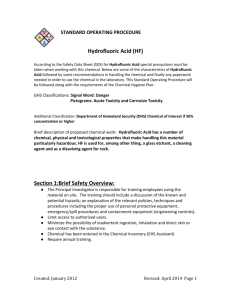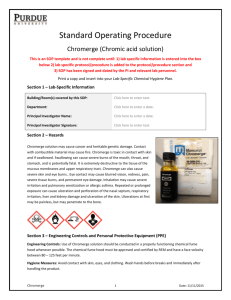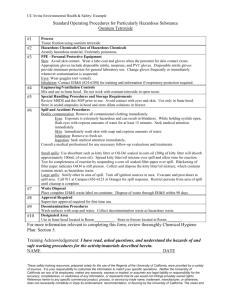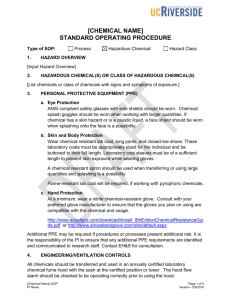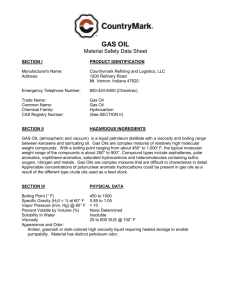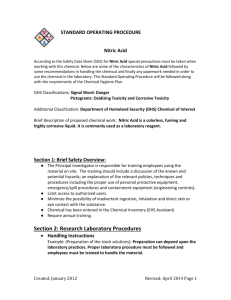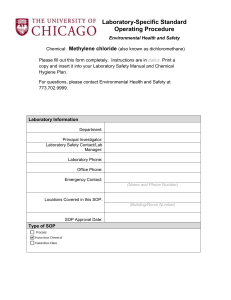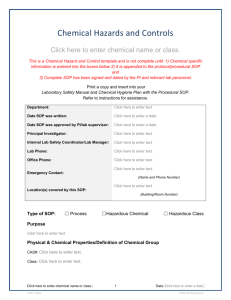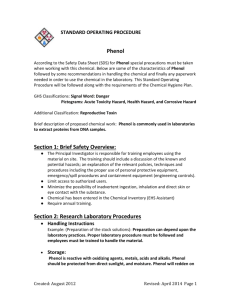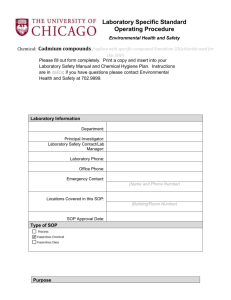Standard Operating Procedure (SOP) template
advertisement
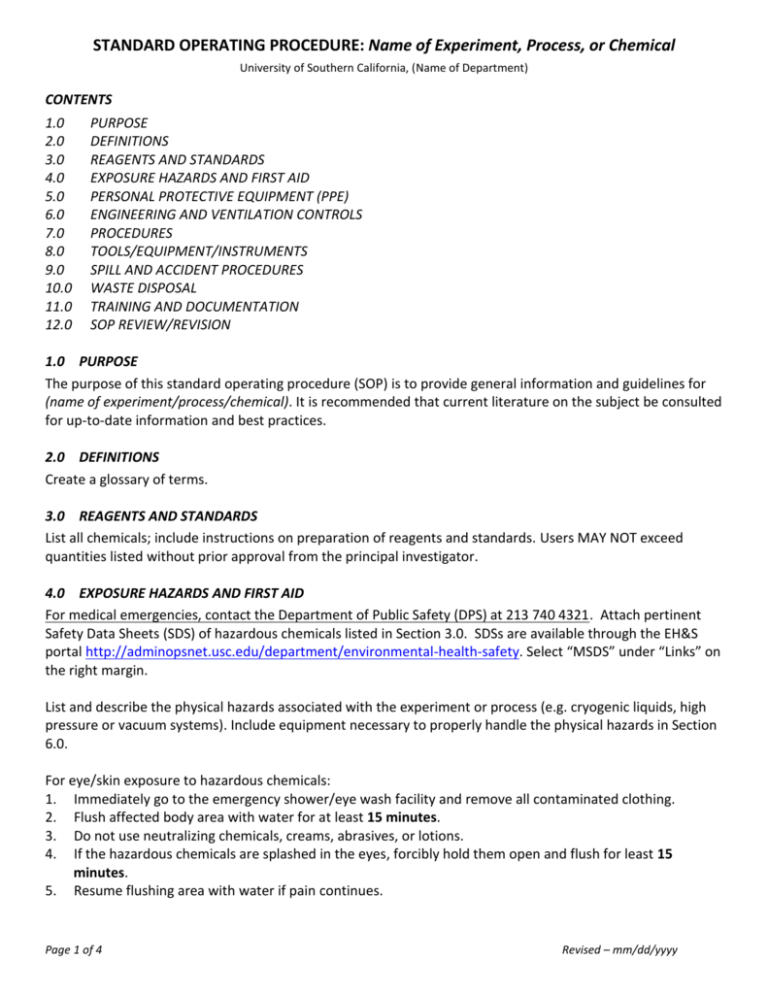
STANDARD OPERATING PROCEDURE: Name of Experiment, Process, or Chemical University of Southern California, (Name of Department) CONTENTS 1.0 2.0 3.0 4.0 5.0 6.0 7.0 8.0 9.0 10.0 11.0 12.0 PURPOSE DEFINITIONS REAGENTS AND STANDARDS EXPOSURE HAZARDS AND FIRST AID PERSONAL PROTECTIVE EQUIPMENT (PPE) ENGINEERING AND VENTILATION CONTROLS PROCEDURES TOOLS/EQUIPMENT/INSTRUMENTS SPILL AND ACCIDENT PROCEDURES WASTE DISPOSAL TRAINING AND DOCUMENTATION SOP REVIEW/REVISION 1.0 PURPOSE The purpose of this standard operating procedure (SOP) is to provide general information and guidelines for (name of experiment/process/chemical). It is recommended that current literature on the subject be consulted for up-to-date information and best practices. 2.0 DEFINITIONS Create a glossary of terms. 3.0 REAGENTS AND STANDARDS List all chemicals; include instructions on preparation of reagents and standards. Users MAY NOT exceed quantities listed without prior approval from the principal investigator. 4.0 EXPOSURE HAZARDS AND FIRST AID For medical emergencies, contact the Department of Public Safety (DPS) at 213 740 4321. Attach pertinent Safety Data Sheets (SDS) of hazardous chemicals listed in Section 3.0. SDSs are available through the EH&S portal http://adminopsnet.usc.edu/department/environmental-health-safety. Select “MSDS” under “Links” on the right margin. List and describe the physical hazards associated with the experiment or process (e.g. cryogenic liquids, high pressure or vacuum systems). Include equipment necessary to properly handle the physical hazards in Section 6.0. For eye/skin exposure to hazardous chemicals: 1. Immediately go to the emergency shower/eye wash facility and remove all contaminated clothing. 2. Flush affected body area with water for at least 15 minutes. 3. Do not use neutralizing chemicals, creams, abrasives, or lotions. 4. If the hazardous chemicals are splashed in the eyes, forcibly hold them open and flush for least 15 minutes. 5. Resume flushing area with water if pain continues. Page 1 of 4 Revised – mm/dd/yyyy STANDARD OPERATING PROCEDURE: Name of Experiment, Process, or Chemical University of Southern California, (Name of Department) 5.0 PERSONAL PROTECTIVE EQUIPMENT (PPE) Check all PPE that apply. NOTE: Include specialized PPE (e.g. SilverShield gloves) in the table if needed. If an air purifying respirator (APR) is required for this SOP, then user must undergo medical surveillance, fit testing, and training prior to use. Gloves Glasses/Goggles Body Nitrile Splash Lab Coat, cotton Neoprene Safety Lab Coat, Nomex Butyl Face Shield* Lab Coat, FR** Leather Optical Filter Apron, FR** * To be used with safety glasses or splash goggles. **Fire Resistant Other Glove selection charts are available at the following web sites: http://www.ansellpro.com/download/Ansell_8thEditionChemicalResistanceGuide.pdf http://www.allsafetyproducts.biz/page/74172 http://www.showabestglove.com/site/default.aspx http://www.mapaglove.com/ 6.0 ENGINEERING AND VENTILATION CONTROLS Conduct experiments in a chemical fume hood or inert atmosphere chamber to guard against hazardous exposure. Ensure that fume hood sash is lowered to between twelve (12) and sixteen (16) inches during use. Set up experiment at least four (4) inches from the sash within the fume hood. Contact FMS Customer Service immediately at 213 740 6833 if fume hood is not working. List additional engineering controls (e.g. blast shield) needed especially where physical hazards are present (e.g. high pressure or vacuum systems). See Section 4.0. If a perchloric acid fume hood is needed, include instructions for use, wash-down cycles, etc. 7.0 PROCEDURES Detail steps in conducting the experiment or process including special handling instructions for the materials listed. Create a flow chart to illustrate the experiment or process if needed. 8.0 TOOLS/EQUIPMENT/INSTRUMENTS List tools/equipment/instruments used and a brief description of each. Include instructions for operation. 9.0 EMERGENCY For general emergencies, follow the steps below. Refer to EH&S’ “Emergency Notification” Fact Sheet (http://adminopsnet.usc.edu/sites/default/files/all_departments/EHS/ehs%20fact%20sheetemergency%20notification-1.pdf) for details. 1. 2. 3. 4. Call DPS immediately. UPC 213.742.4321, HSC 323.442.1000 Call EH&S. Dial 323.442.2200 Supply name; call back number; nature of the emergency and location. Report the emergency to the supervisor, lab manager, or principal investigator. Page 2 of 4 Revised – mm/dd/yyyy STANDARD OPERATING PROCEDURE: Name of Experiment, Process, or Chemical University of Southern California, (Name of Department) 9.1 SPILL AND ACCIDENT PROCEDURES In the event of a large (> 1 liter) chemical spill, follow these guidelines: Notify everyone in the immediate area and the supervisor. Evacuate personnel from the spill area. Deny entry. Alert other building occupants. NOTE: Evacuation of the building and its occupants may be necessary depending on the volume of chemical spilled and its relative hazard. Notify DPS at 213 740 4321 from a safe location and provide the following information: o Name, telephone number, and location; o Type of incident, location, and time of occurrence; o Name and quantity of material involved, to the extent known; o If victims are involved, relay the victim(s)’ name(s) and extent of injuries, if any; o If exposed to a hazardous spill, see 7.9.2 Chemical Exposure. Small spill (< 1 liter): 1. Prevent the spill from spreading by depositing absorbent material such as Super Fine, sand, or vermiculite (paper towels do not control the vapor release as well as sand) at its outer edges. 2. Cover the entire spill with the absorbent by working from the edge toward the center in a circular motion. 3. Mix the absorbent until it has absorbed all of the hazardous liquid. 4. Collect the absorbent with plastic dust pan and broom and place it in a Ziploc bag. 5. Follow steps #6 and #7 of 10.0 WASTE DISPOSAL section below. NOTE: Chemical spill clean-up must not be attempted if the employee does not have the proper training and experience, the necessary spill kit supplies, and personal protective equipment. 10.0 WASTE DISPOSAL 1. Collect the chemical waste in appropriate containers described in the table below. Do not commingle or mix dissimilar waste streams. 2. Download and fill out a Chemical Waste Disposal Form (http://capsnet.usc.edu/sites/default/files/all_departments/EHS/chemwastedispform.pdf) to accompany each waste container. 3. Containers must be sealed airtight with a screw-on lid. They must also be in sound condition, leak-proof, and appropriate for the waste type. Rubber stoppers, corks, and parafilm are NOT allowed. 4. Do not fill liquid containers to more than 80% capacity. The top and sides of the container must be free of liquid residue. 5. Solid chemical waste can be collected in plastic bags, fiber boxes, or plastic containers. 6. Obtain a hazardous waste tag or adhesive label and fill in required information. Affix to the container. 7. Contact EH&S for waste pick-up at: http://capsnet.usc.edu/node/322. Page 3 of 4 Revised – mm/dd/yyyy STANDARD OPERATING PROCEDURE: Name of Experiment, Process, or Chemical University of Southern California, (Name of Department) 11.0 TRAINING AND DOCUMENTATION The Principal Investigator must ensure that his/her research group is trained in the application of this SOP by the principal investigator himself/herself or designee. Each user will enter his/her name, physical or electronic signature, and date below once he/she has read and understands the content of this SOP. The Principal Investigator will maintain this document (electronic or hard copy) in his/her files or central repository and will make it available upon request by EH&S during periodic or impromptu inspections. Each user will have access to a copy of the signed document. NOTE: Users are subject to all applicable safety trainings including the General Lab Safety Course, annual laboratory safety training refresher, etc. Name Signature Date 12.0 SOP REVIEW/REVISION Date prepared: By: (Name of preparer/reviewer for internal SOPs; department name for external SOPs) Date revised: By: (Name of preparer/reviewer for internal SOPs; department name for external SOPs) Page 4 of 4 Revised – mm/dd/yyyy

